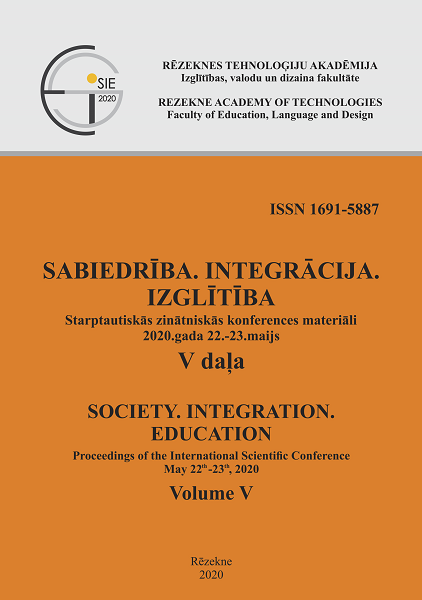PROMOTION OF CRITICAL THINKING IN DANCE CLASSES FOR YOUTH
DOI:
https://doi.org/10.17770/sie2020vol5.4969Keywords:
critical thinking, dance classes, dance pedagogyAbstract
Nowadays, very topical is the ability to communicate, cooperate, make decisions, become co-responsible and think critically. Critical thinking plays a crucial role, as its primary function is the ability to choose between alternatives and make decisions. One must be able to justify one's decisions and beliefs. Critical thinking is just as necessary as reading and writing, and is one of the components of today's curriculum. Critical thinking is based on intellectual criteria. It is the clarity, validity, accuracy and honesty of thinking. Dance classes are a popular leisure activity for young people. Youth are best in contact with a teacher who is a friend, mentor and someone to resemble. If a dance teacher include exercises in his class to promote critical thinking it gives the opportunity to unite dancers, gain dancers who are aware of their abilities and who work to improve their weaknesses. The purpose of this article is to explore the promotion of critical thinking among young people in dance classes and it will be more successful if a system of exercises appropriate to the age of the youth is purposefully designed and implemented. In the practice of dance pedagogy, the promotion of critical thinking in dance classes is a novelty. In the study participated dancers aged 16-25. The research consists of several stages: development of an exercise system to promote critical thinking; introduction of exercises in dance classes in the theater dance studio “Savanna”; measuring exercise efficiency; analysis of results; making recommendations. In total, five tests were used in the study: "Conclusion", "Recognition of Assumptions", "Deduction", "Interpretation", "Evaluation of Arguments".
Downloads
References
Astleitner, H. (1998). Kritisches Denken.Innsbruk–Wien. Studien Verlag.
Burāne, K. (2001). Nedomāt … domāt … domāt … kritiski. Vēstis Skolai. Pielikums. Pieredze. A-C.
Chen, W. & Cone, T. (2003). Links Between Children’s Use of Critical Thinking and an Expert Teacher’s Teaching in Creative Dance. Journal of teaching in physical education. 22, 169-185.
Connerly, D. (2006). Teaching Critical Thinking Skills to Fourth Grade Students Identified as Gifted and Talented. Graceland University Cedar Rapids, Iowa. Retrieved from http://www.criticalthinking.org/pages/teaching-critical-thinking-skills-to-fourth-grade-students-identified-as-gifted-and-talented/685
Hаlpern, D. (2000). Psihologija kriticheskogo myshlenija. Sankt-Peterburg:Piter.
Fisher, A. (1991). Critical Thinking. A Survey of Programs in Education. London, Bristol: Classical Press.
Klūsters, D. (2001). Kas ir kritiskā domāšana? Tilts. Informatīvs izdevums izglītības darbiniekiem,. 2–9, 12.
Mill, J.S. (1858). On Liberty. London: Longman, Roberts & Green.
Pedagoģijas terminu skaidrojošā vārdnīca.(2000). Sast. autoru kol. V. Skujiņas vadībā. Rīga: Zvaigzne ABC.
Stikute, E. (2006). Kritiskās domāšanas attīstīšana literatūras mācībās. Latvijas Universitātes raksti 700. Sēj, Pedagoģija un skolotāju izglītība. Rīga: LU.
Stīla, Dž, Meredits, K.S., & Templs, Č. (1998). Kritiskās domāšanas principu sistēma mācību satura apguvē. SFL programmas Pārmaiņas izglītībā projekta Lasīšana un rakstīšana kritiskās domāšanas attīstīšanai. Rokasgrāmata I.
Thomas, P.E. (1999). Critical Thinking Instruction in Selected Greater Los Angeles Area High Schools .A dissertation Submitted to the School of Education and Behavioral Studies in partial fulfillment of the requirements for the degree Doctor of Education. Retrieved from http://www.criticalthinking.org/files/Azusa%20Pacific%20University_opt.pdf


